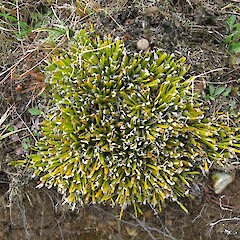Carmichaelia monroi
Common name
stout dwarf broom
Synonyms
Carmichaelia monroi var. longecarinata G.Simpson
Family
Fabaceae
Flora category
Vascular – Native
Endemic taxon
Yes
Endemic genus
No
Endemic family
No
Structural class
Trees & Shrubs - Dicotyledons
NVS code
The National Vegetation Survey (NVS) Databank is a physical archive and electronic databank containing records of over 94,000 vegetation survey plots - including data from over 19,000 permanent plots. NVS maintains a standard set of species code abbreviations that correspond to standard scientific plant names from the Ngä Tipu o Aotearoa - New Zealand Plants database.
CRMMON
Chromosome number
2n = 32
Current conservation status
The conservation status of all known New Zealand vascular plant taxa at the rank of species and below were reassessed in 2017 using the New Zealand Threat Classification System (NZTCS) – more information about this can be found on the NZTCS website. This report includes a statistical summary and brief notes on changes since 2012 and replaces all previous NZTCS lists for vascular plants.
Please note, threat classifications are often suggested by authors when publications fall between NZTCS assessment periods – an interim threat classification status has not been assessed by the NZTCS panel.
- Conservation status of New Zealand indigenous vascular plants, 2017 . 2018. Peter J. de Lange, Jeremy R. Rolfe, John W. Barkla, Shannel P. Courtney, Paul D. Champion, Leon R. Perrie, Sarah M. Beadel, Kerry A. Ford, Ilse Breitwieser, Ines Schönberger, Rowan Hindmarsh-Walls, Peter B. Heenan and Kate Ladley. Department of Conservation. Source: NZTCS and licensed by DOC for reuse under the Creative Commons Attribution 4.0 International licence.
2017 | At Risk – Declining | Qualifiers: DP
Previous conservation statuses
2012 | Not Threatened
2009 | Not Threatened
2004 | Not Threatened
Brief description
Rare, very low-growing leafless shrub consisting of erect flattened yellow-green branches with a blunt orange or red tip. Branches 3–5mm wide, grooved, blunt-tipped. Flowers pea-like, pink with dark purple centre, base hairy, in clusters. Fruit a dry pod with hard seeds and which do not split open.
Distribution
Endemic. New Zealand: South Island (Marlborough and Canterbury).
Habitat
Inhabiting stable slopes, terraces, eyots within braided river; also amongst loose rock, scree debris, and eroding soils at the interface between rock outcrops and unstable scree and the adjacent tussock and shrub vegetation.
Detailed description
Dwarf, spreading shrub, up to 0.15–0.25 × 0.40–1.00 m. Branches stout, ascending and horizontal, 10–35 mm diameter. Cladodes linear, striate, compressed, erect to spreading, green to green-bronze, often hairy when young, glabrous at maturity, 22–75 × 2–6 mm; apex obtuse, yellow, green, bronze, or red; leaf nodes 2–4. Leaves simple, oblanceolate, fleshy, green to green-bronze, present on seedlings and occasionally mature plants, 5.0–8.0 × 2.0–4.5 mm; both surfaces with scattered hairs; apex emarginate to retuse; base cuneate; petiole glabrous or sparsely hairy, 1.5–2 mm long. Leaves on cladodes reduced to a scale, broadly triangular, glabrous, 0.5–0.6 × 0.9–1.1 mm; apex obtuse. Stipules free, broad-triangular, 0.25–0.40 × 0.75–0.90 mm; upper surface glabrous; lower surface hairy, becoming glabrous with age; apex subacute; margin hairy. Inflorescence a raceme 1–2 per node, each with 1–3 flowers. Peduncle hairy, green, 6–8 mm long. Bracts triangular, glabrous, pale green to tan, < 0.5 mm long; apex acute; margin hairy. Pedicel hairy, pale green, 3–4 mm long. Bracteoles at base of calyx sometimes absent, glabrous, < 0.4 mm long; apex subacute; margin hairy. Calyx campanulate, 2.5–3.0 × c. 2.0 mm; inner surface glabrous, green; outer surface hairy, green. Calyx lobes triangular, green and often flushed red, < 1 mm long; outer surface densely hairy; apex acute, often black; margin hairy. Standard obovate, patent when young, reflexed at maturity, positioned at proximal area of keel, keeled, 6-7 × 5-6 mm; distal and central areas of upper surface purple, proximal area pale green, margins white, sometimes purple-veined; distal and central area of lower surface white, proximal area pale green, sometimes purple-veined; apex retuse; margins recurved; claw pale green, c. 3 mm long. Wings oblong, shorter than keel, 7–8 × c. 2 mm; distal and central areas of adaxial surface purple, proximal area green; distal and central areas of abaxial surface white, proximal area pale green; auricle triangular, pale green, apex subacute, c. 1 mm long; claw pale green, c. 2 mm long. Keel 8.5–10.0 × 3.0–4.0 mm; distal and central areas of upper surface purple, proximal area pale green; auricle triangular, pale green, with subacute apex, c. 1.5 mm long; claw pale green, 3.0–3.5 mm long. Stamens 8.5–10.0 mm long; lower filaments connate for c. ⅔ length and outside filaments free for 2.5–3.5 mm. Pistil slightly exserted beyond stamens, 8.5–11.0 mm long; style bearded on upper surface; ovary weakly falcate, glabrous; ovules 11–12. Pod oblong or oblanceolate, laterally compressed, often weakly falcate, brown, dark brown, or black, usually indehiscent, 11.0–15.0 × 3.5–5.5 mm; beak on adaxial suture, stout, pungent, < 1 mm long. Seeds oblong-reniform, 3–11 per pod, dull yellow or orange, brown-green, or olive green, often with black mottling, 2.0–2.5 × 1.5–2.0 mm.
Similar taxa
C. monroi is similar to C. astonii G.Simpson and C. vexillata Heenan. From C. astonii it is distinguished by its smaller habit, cladodes, and flowers; and from C. vexillata by the triangular or broad-triangular stipules.
Flowering
November–January
Flower colours
Violet/Purple, White
Fruiting
December–May
Life cycle
Seeds are possibly dispersed by wind and granivory (Thorsen et al., 2009).
Propagation technique
Easily grown from seed and hardwood cuttings. A beautiful shrub, which deserves wider cultivation.
Etymology
carmichaelia: After Carmichael, a botanist
monroi: Named after Sir David Monro who was a 19th century New Zealand politician
Where To Buy
Not Commercially available.
Attribution
Description adapted from Heenan (1995).
References and further reading
Heenan PB. 1995. A taxonomic revision of Carmichaelia (Fabaceae - Galegeae) in New Zealand (part I). New Zealand Journal of Botany 33(4): 455–475. https://doi.org/10.1080/0028825X.1995.10410618.
Thorsen MJ, Dickinson KJM, Seddon PJ. 2009. Seed dispersal systems in the New Zealand flora. Perspectives in Plant Ecology, Evolution and Systematics 11: 285–309. https://doi.org/10.1016/j.ppees.2009.06.001.










